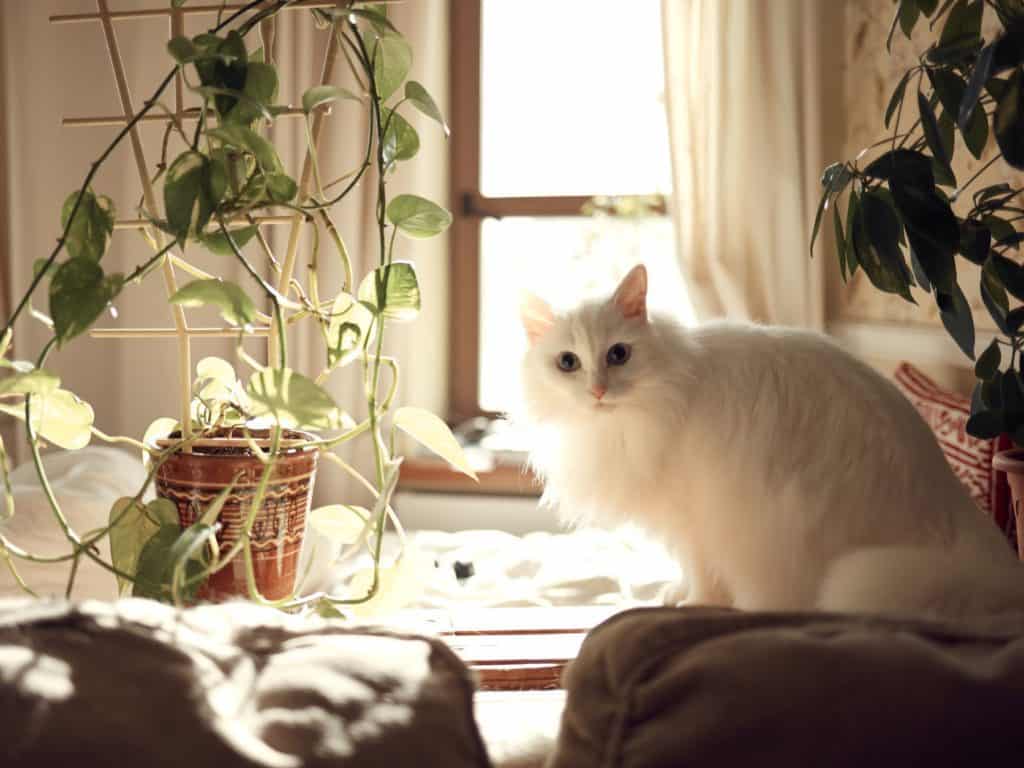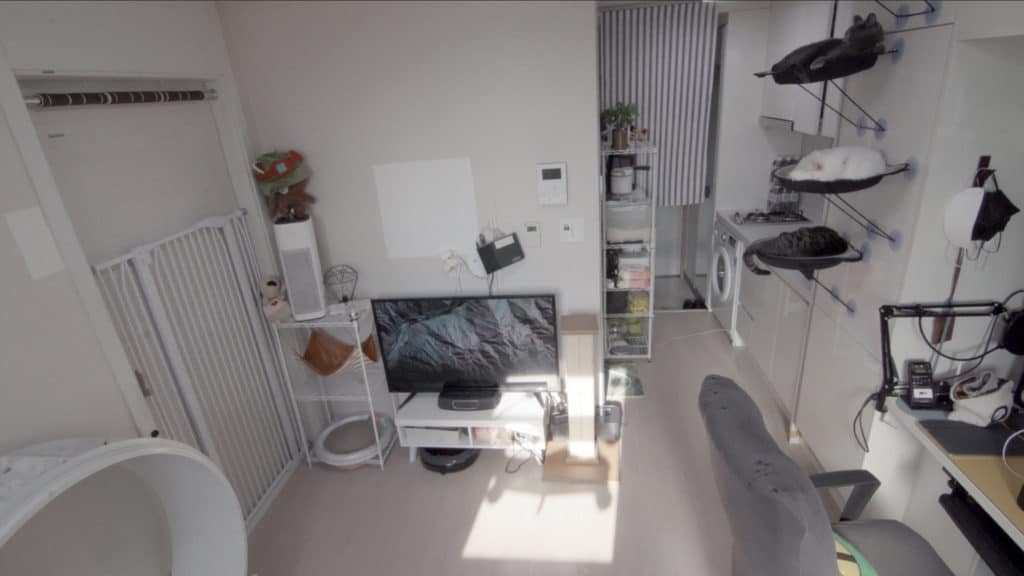Living in a small apartment such as a studio apartment can be difficult because of the limited space, and it can be even more difficult with a cat companion. However, your cats can be safe, engaged, and stimulated with some creativity and preparation, even in a small living space. Here are the top tips that I have learned living with four cats in a small or studio apartment for the past few years!

Tips to Create a Cat-Friendly Studio Apartment
1. Keep Cats Off of Floors: Catification With Suction Cup Hammocks/Racks/Poles
Cats lounging for extended periods around on the floor is a safety hazard to you and themselves. Of course, it’s okay to be on the floor when they’re eating and drinking water. However, if they’re always on the floor even when it isn’t mealtime, then there might not be enough cat-centric spaces for them.
Provide a lot of vertical perches by using cat furniture or even human furniture repurposed for the use of both cats and their humans. Think about how your cat can move on these vertical spaces and create paths for them to play and navigate around the room without touching the floor. Check out my curated list of the best cat furniture for small apartments here!
Keeping cats off the floor has three benefits:
- Gives you back more of that valuable floor space.
- More stimulation, engagement for your cat friends.
- Gives cats more territory to explore and claim.
Focus on Underused Windows/Glossy Surfaces
There are no better items to create cat-friendly spaces in apartments than cat suction cup hammocks and perches. They’re relatively cheap, sturdy, and incredibly flexible as they can be stuck on anything smooth or glossy. These items are often put on windows, but they can be attached to many other surfaces!
Additionally, these glossy surfaces are usually unused surfaces by humans, and these areas typically don’t have perches and places to climb for our cats (such as the kitchen area). In the past, I have stacked perches on my cabinets, drawers, and even Refrigerators! Refrigerator doors are great because they provide some exciting spots for our cats to perch to allow them to observe what’s cooking at a safe distance.

Another added benefit is that nothing gets damaged because it uses suction power to stick onto surfaces. Many people are renting their apartments or homes, and there might be issues associated with drilling or nailing things to the wall. This is perfect as it respects that and still provides our cats with what they need.
Use Racks/Book Cases and Similar Items For Space Efficiency
Again, the one thing that’s the most scarce in a small apartment is floor space. If I lay down on the floor in my apartment, I can almost touch the other side of the room! The ability to stack things on top of each other is an absolute must in these types of living spaces.
Not only are racks great for storage, but these types of furniture can be used by both you and your cats. Cats love to jump on anything with some verticality, so it’s easy to create cat-centric places by putting toys or putting a cat bed on one of the levels!
Moreover, I believe organization through racks and similar items is one of the factors for the proper development of your cat! Things lying around in the open are subject to being used as a toy or worse. As a result, it can develop into a destructive habit! Only leave the things that cats can interact with on the lower levels (such as toys, food, or water).
2. Create Predictable Habits: Have a Routine for Your Cat’s Meals and Play
A routine is vital for your productivity and relationship with your cats in a small one-room studio apartment. Probably you have a life outside of taking care of your cats, and you don’t want to keep an eye on them 24/7. Cat owners have to be able to trust their cats.
Additionally, having a good routine allows your cats to adapt to your personal lifestyle. What does this mean? This means that your cats are able to develop good, non-destructive habits that also allow you the time and space to do your work or sleep (this is especially important)!
For my cats specifically, I know that they won’t freak out in the dead of night or be destructive with my things. They have toys that they prefer and stick to. They’ve also been on the same schedule for the past few years, so they know when to be active and when it is time to sleep. This comes from, again, meal and play scheduling and proper training!
Make Time to Play With Your Cats Regularly
Playtime has a lot of meanings to a lot of people, but for cats, it means to hunt. A cat’s playtime is as important to cats as walking is to dogs. Usually, however, play is just something that’s done from time to time rather than part of a routine.
Playing and hunting fulfill cats in a way that nothing else does. In combination with meal times, you can create such an intense routine for a cat that you can guide them behaviorally and energetically. Please read my article for the most optimal times to schedule playtimes with your cats!

In my apartment, I play with all my cats together. As they play around each other, they create positive associations. This is one of the tools that I use to introduce any new cat to my home. It allows them to quickly get past the introduction phase and adapt to their new environment (and roommates). I have never had an introduction last more than a couple of days!
Don’t Free Feed Your Cats! Have Actual Meal Times
Mealtimes, not free feeding, is another tool used to create positive associations. Cats in the wild have to hunt for their food, and as such, they are very food motivated animals.
Free feeding creates health issues for your cats and should try to be avoided:
- First, It also doesn’t allow you to observe your cat’s eating habits. A cat that doesn’t eat well or vice versa (a cat that eats too much), is usually a sick cat.
- Allowing cats to feed at random times means your cats will also have energy at random times.
- Free-feeding doesn’t allow for proper food portioning, which can lead to obesity and other health issues. For chonky cats, there are effective strategies to use in combination with scheduled mealtimes to lose weight!
After a good play session, giving a cat food completes its instinctual cycle from hunting to catching their “prey” to finally, eating their meal. After every big meal, you’ll find that they will groom and become quite sluggish as it’s ingrained into every cat to conserve energy after a meal.
3. Protect Your Valuables: Keep Sensitive/Valuable Objects High & Out of Sight
Most cat owners might have a similar experience where they have caught their cats getting into cabinets drawers to fish out some food/snacks. Anything below the waist is fair play for a cat as a general rule. Food-related or relatively valuable should be put in overhead cabinets – if not available, use safety locks!
One of the four cats in my studio apartment is a Bengal cat. They are notorious for being high maintenance, intelligent, and persistent enough to open doors and cabinets. I’ve watched my Bengal cat push his paw in and use his body as support to open cabinets and cupboards. However, he can’t do that with cabinets he has to reach for.
Keep Cables Away From Cats!
In a small apartment, you might have many appliances and devices close together. This is usually no problem, but with cats and especially young cats with their teeth starting to grow in, you don’t want them to bite those cables for obvious reasons.
As said before, habits get picked up quickly, and you don’t want them to make a habit out of biting cables (especially painful if your computer is around). Therefore, it’s best to tie cables together and route them in a way that’s hard to reach or away from your cat’s sight.
It’s important to note the environment gives our cats a message, and the yes/no concept is a training concept that every cat owner should know. Rather than disciplining or punishing our cats (which increases our cat’s risk for aggressive behavior), we can guide our cats to know what’s appropriate or inappropriate to interact with through intelligent placement (or displacement) of things.
3. Automate or Streamline The Menial Tasks
Our cats are great and having the experience of living with cats is something that I love. However, the cleaning is something I can do without, truth be told. Cats shedding and litter tracking are two of the main problems in a small space!
I’d always recommend having a robotic vacuum and an air purifier for reducing cat hair on surfaces. It’s just so efficient and saves a lot of time. You can imagine how much hair is around my home with four cats. However, you might be surprised that I only manually vacuum maybe once a week. My robotic vacuum takes care of the day-to-day, and the air purifier cleans the air of the other particulates and fur that might be flying throughout my apartment!
I primarily use pine litter for cat litter, and it is a much better alternative to clay (sand) litter in a studio apartment. There is little to no litter tracking, and whatever litter comes out is caught in the litter mat. This allows me to quickly and efficiently clean up and keeps my apartment smelling a lot better!

Great content, thank you for sharing!
This really interesting, but one of the things I struggle with, especially in winter when I can’t open windows as often, is cat litter odors. Even though I scoop their boxes once a day and even though I scrub out the boxes with lemon juice and hydrogen peroxide when I change the litter, I feel like there is always some level of odor. How do you address cat litter odors in a small space.
I understand that struggle! Winter time is difficult cause it’s cold and there’s less ventilation going around because of it. There are two tools that I use for smells in winter!
1. Baking soda or coffee grounds to add in the litter box (really helps to reduce the smells)
2. A powerful air purifier with a carbon filter – most air purifiers will have HEPA filters which take away the particles and hair but a carbon filter will take away the smells. While they might be a bit of an investment, carbon filters take out a lot of the stuff that causes bad smells in the air!
You can find the stuff I use and recommend for smells here: https://monsieurtn.com/product-review/recommended-apartment-cat-products/#Smells_and_Odor
Thank you for the article!